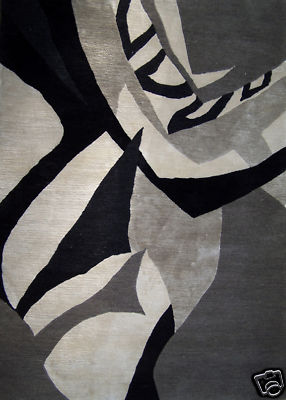By Carolyn Edlund
How does a visual artist become a rug designer? Artist Danielle David Grinnen has transformed her business this way.

“Expectations” rug interpreted from artwork by Danielle Grinnen
AS: You started out as a painter. How did you get involved with rug design?
DG: A common thread in my life has been an innate love for color, texture and balance. I have always enjoyed vivid color combinations, creative use of texture and an intrinsic sense of balance in all of nature.
In college, as I took painting, design and art history classes I began to consciously realize that I saw the world with an artist’s eye. I began to find the use of painting with texture an intuitive and vibrant, unexpected colors together essential to my work as an artist.
This love for balance, color and texture translated into my design work for Randall J. Kipp Architecture in Irvington, Virginia. All throughout working in interior design, I continued pursuing my own creativity. Having sourced many area rugs for clients, I was intrigued by the way that the color and texture of rugs lent itself to painting. So in 2004, I began researching having area rugs made.
AS: Could you tell us about the rug weaving industry in South East Asia, and why you work with the GoodWeave organization?
DG: I wanted my rugs to be beautifully handmade of quality materials. As I researched, I found there was a lot of corruption in the rug industry with exploitative child labor. Essential to my work was that people were treated fairly and the making of each rug was done with integrity from start to finish. I found out about the RugMark USA foundation that certifies rugs with the GoodWeave label and its quest to end child labor in the rug industry of South East Asia. GoodWeave offers a holistic approach to the problem of child labor.
In the summer of 2005, I began Deliante Designs LLC and proudly became a licensee of RugMark so each of my rugs carries the Good Weave certification label. Thus began my work with a wonderful carpet mill in Kathmandu, Nepal and started the making of my paintings into hand knotted carpets in the Tibetan weave.
AS: How does the process of ordering custom rugs work?
DG: Modern design meets ancient craft. The collaborative process of creating a custom rug begins with a simple conversation about the space that the rug will reside-color, size, style, and concept. I may go to your space for inspiration or just receive images from you if the place is far away. Then I will go back to my studio and create design ideas by painting and drawing; this usually takes two to three weeks.
The designs are presented and together we can tweak design ideas. We choose colors, materials, pile height, size and knot count. Deliante Designs rugs are created of beautiful materials such as Tibetan wool, Chinese Silk, hemp, nettle, Pashmina wool and New Zealand Wool. A strike off, usually a 2’ x 2’ foot section of the rug, can be made to be sure that the color and design is exactly right.
After the final design is confirmed, a contract is signed. The design is sent to my carpet mill in Nepal where the materials have been hand carded, hand spun and are ready to be hand dyed to the colors we have chosen. The rug is hand knotted on the loom by expert adult artisans. I keep you apprised during this entire process all the way to its arrival to your space.
AS: How have you marketed your work?
DG: Though the business side of the art world is notoriously elusive for artists, the intuitive, problem-solving aspects of the creative mind make having an artist-run business a real possibility. Every marketing attempt has been a constant learning process to make the entire business work.
I have participated in trade shows on the East and West coasts. My rugs appear in major home magazines such as “Dwell” and “Architectural Digest” and in more regional magazines like “Virginia Living”. Recently, I have found making phone calls and sending emails to architectural and design firms has given me inroads, getting opportunities to present my rugs to groups of architects and designers and in smaller one-on-one settings. When people actually see, walk on and touch the rugs, they sell themselves.


Great interview, Danielle. I’m so excited for the growth of your business. Thanks for the mentions.
She is doing a great job, and it’s to your credit Jennifer that your students are so successful!
Check out another article on Danielle’s rug designs at http://www.bit.ly/dzluqi
hi
I wonder if you would share your thoughts on remuneration for use of another artist’s design to make a highend wool carpet. Specifically, what percentage of the retail value would you pay the artist for use of thier original design. Maybe you have only worked with your own designs but any insight on this would be helpful. I am an artist and have been approached by a reputable, experienced designer.
Deborah, that would involve licensing to the manufacturer. The typical artist receives royalties in the range of 3-10% (that is the percentage of wholesale price, not retail price). This will vary by industry and the company that is licensing.